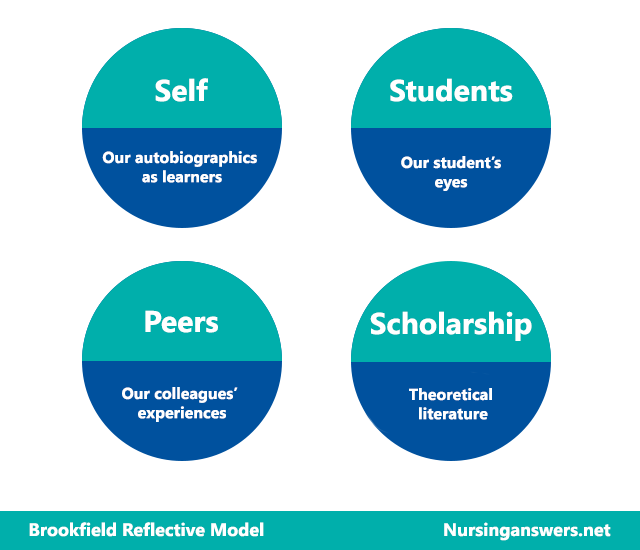Introduction
Brookfield's reflective model takes a different stance compared to other nursing models, and asks us to consider teaching practice not in cyclical terms, but from multiple perspectives.
Brookfield's four lenses of reflection
In Brookfield's model, we should consider reflection from four perspectives: from our own standpoint, from that of our learners, from that of our colleagues, and from its relationship to wider theory. Only from the consideration of multiple points of view can we deepen our reflection. The four lenses Brookfield suggests may be presented in the diagram below:

1. Ourselves
For Brookfield, the autobiographical aspect of reflection, when we look back at our own experiences and feelings, is central to any valid process of critical reflection. We may draw from our own past as well as from current experiences which may have provoked the reflective journey. Brookfield suggests that a thorough inventory is taken, so that we do not merely re-assess the moment, but that we look back at our pasts as teachers, as trainees, and as learners ourselves, in order to be able to work towards revealing the full nature and extent of elements of our teaching practice which may require reappraisal.
2. Our Learners
Students' perspectives may give insight which might otherwise have been missed if the focus of the self-reflection had been purely upon the individual themselves. Student-oriented reflection might encompass looking back at work produced by learners, at their feedback and grades, at tutorial records and at journals. Survey and questionnaire data on quality of teaching and of classroom experience might be valuable also.
3. Our colleagues
A further mode of investigation into the self involves going beyond learners and involves taking peers and other colleagues' perceptions and observations into consideration. Peer observation and other review processes can reveal biases and assumptions in one's teaching, and can bring to light aspects which one might not consider otherwise.
4. Theoretical contexts
In the Brookfield reflective model, teachers need to be engaged in the investigation of their teaching practice; the training of teachers does not end with the final assessment of the teacher training course, but is instead a life-long journey. Engagement with critical reading, with subject scholarship, with the political and other contexts of contemporary teaching, and with higher qualifications all serve to deepen and refresh the connections between pedagogy in practice, and with critical engagement with that practice.
Teachers may also realign themselves with theory through a re-engagement with critical reading, and may derive fresh insights from their experience of reviewing their practice from an array of theoretical standpoints. This kind of engagement fosters links beyond the immediate setting, and the knowledge and experience of one's peers and out towards broader communities of knowledge. A full investigation of oneself and one's practice, then, takes in multiple considerations, and applies them back to one's teaching, which can then be informed not only by a subjective response to reflection, but may be filtered through peer, theoretical, and through learner engagements also.
Evaluation
One advantage of Brookfield's model as outlined here is that it takes a holistic perspective, and addresses teaching from a selection of standpoints. It may be thought particularly useful for making summary observations, for example as part of end of year reviews, or in reflecting on engagements with a training course. The breadth of observations may be insightful also.
Issues with the model as described may include the point that the model is less useful for making assessments of teaching in action; it is more suited to summative, rather than live, reflection, and perhaps is less useful for immediate use as a consequence. In addition, the lenses may be difficult to articulate, and require not only time-consuming and detailed working, but result in a variable and skewed picture.
Cite This Work
To export a reference to this article please select a referencing style below:

